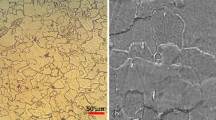Abstract
The present study reports microstructural characteristics of two grades of steels, stainless steel (SS 304) and carbon steel welded using tungsten inert gas (TIG) and activated flux-TIG (A-TIG) processes. Activated fluxes such as TiO2, ZnO and MnO2 are effective for A-TIG welding of dissimilar weld between carbon steel to stainless steel. Mechanical properties, joint efficiency of A-TIG welds are found to be higher than normal TIG Welds. This study attempts to establish a correlation between observed mechanical behavior (hardness and strength) and the microstructural characteristics of the weld samples. Significant differences in microstructures are recorded in terms of grain size, local misorientation, grain and phase boundary characteristics in distinct regions of the welded samples. The microstructural observations exhibit: (1) the presence of Widmanstatten ferrite structure at the heat affected zone of the carbon steel part in the A-TIG welded specimen and (2) differences in structure at the interface of stainless steel and weld metal region under the two conditions of welding. These structures are morphologically different and shows differences in the number fraction of 45° <114> phase boundary orientation relationship. The microstructure also displays significant heterogeneity in grain size and grain misorientation.








Similar content being viewed by others
References
Nayee S G, and Badheka V J, J Manuf Proc 16 (2014) 137.
Badheka V J, Weld Cut 14 (2015) 54.
Huang H Y, Shyu S W, Tseng K H, and Chou C P, J Mater Eng Perform 17 (2007) 193.
Q.M. Li Qing, X.H. Wang, Z. Zou, and J. Wu, Nonferrous Met Soc China 486 (2007).
Kuo C H, Tseng K H and Chou C P, Eng Mater 479 (2011) 74.
Radhakrishnan V M, Welding Technology & Design, New Age International Publisher, Second edition 2005, ISBN 81-224-1672-1, pp 103.
Dhandha K H, Badheka V J, J Manuf Proc 17 (2015) 48.
Colegrove P, Ikeagu P, Thistlethwaite A, Williams A, Nagy A, Suder W, Steuwer A, and Pirling T, Sci Technol Weld Join 14 (2009) 717.
Schwartz A J, Kumar M, Adams B L, and Field D, Electron Backscatter Diffraction in Materials Science, New York: Springer, (2009).
Fujii H, Ueji R, Takada Y, Kitahara H, Tsuji K, Nakata N, and Nogi K, Mater Trans 47 (2006) 239.
Coelho R S, Kostka A, Pinto H, Riekehr S, Koçak M, and Pyzalla A R, Mater Sci Forum 571–572 (2008) 361.
Merson E, Hammond C, and Brydson R, Characterization of texture in Ti-6246 alloy fiber laser welds using electron backscattered diffraction, J Phys Conf Ser 26 (2006) 347.
Kamaya M, Wilkinson A J, and Titchmarsh J M Nucl Eng Des 235 (2005) 713.
Verlinden B, Driver J, Samajdar I S, and Doherty R D, Thermo-Mechanical Processing of Metallic Materials, ISBN-978-0-08-044497-0, Pergamon Materials Series. Series ed. R.W Cahn, Amsterdam:Elsevier, (2007).
Taljat B, Radhakrishnan B, and Zacharia T, Mater Sci Eng A 246 (1998) 45.
Elmer J W, Wong J, and Ressler T, Mater Trans A 32 (2001) 1175.
Arivazhagan B, and Vasudevan M, J Manuf Proc 16 (2014) 305.
Tseng K H, Powder Tech 233 (2013) 72.
Miller D K, Use Undermatching Weld Metal Where Advantageous, Technical Article, Welding Innovation Vol. XIV, No. 1, (1997).
Frankel J, Abbate A, and Scholz W, Expt Mech 33 (1993) 164.
Acknowledgments
Authors are grateful to Pandit Deendayal Petroleum University (PDPU), Gandhinagar, India and University of Saskatchewan (UoS), Canada for conducting experimental work and high end characterization of the welded samples respectively. Dr Badheka of PDPU is also thankful to the Board for Research in Fusion Science and Technology (BRFST), Institute for Plasma Research (IPR), Gandhinagar, India for sponsoring the research project via project number NFP-08/MAT/01.
Author information
Authors and Affiliations
Corresponding author
Rights and permissions
About this article
Cite this article
Badheka, V.J., Basu, R., Omale, J. et al. Microstructural Aspects of TIG and A-TIG Welding Process of Dissimilar Steel Grades and Correlation to Mechanical Behavior. Trans Indian Inst Met 69, 1765–1773 (2016). https://doi.org/10.1007/s12666-016-0836-5
Received:
Accepted:
Published:
Issue Date:
DOI: https://doi.org/10.1007/s12666-016-0836-5




